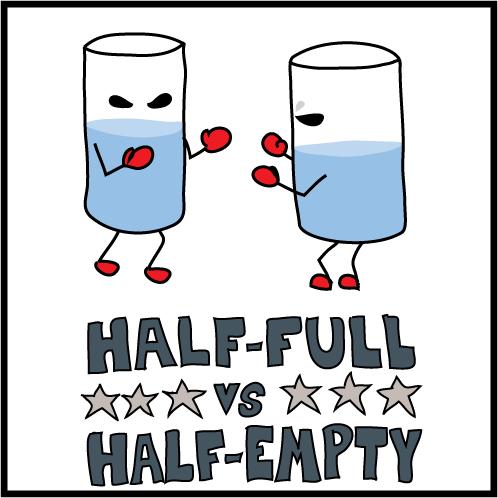I recently watched a TED talk video by Alison Ledgerwood on YouTube. In the video, Alison gives the example of her paper getting accepted for publication (positive news) and another one getting rejected for publication (negative news). She talks about how it takes longer to recover from (i.e., go back to being her normal self) a piece of negative news as compared to a piece of positive news. While she makes a lot of good points in the video (and I do recommend that you watch it), here is what stuck with me.
- The glass-is-half-full (positive thinking) is the “gain frame”. When things are positioned this way, the listeners:
- Take a positive view of what you are describing
- Are able to switch to the loss frame when new information is presented
- The glass-is-half-empty (negative thinking) is the “loss frame”. When things are positioned this way, the listeners:
- Take a negative view of what you are describing
- Have difficulty switching to the gain frame when new information is presented
Further, she provided a simple example where users had to do simple math to convert from one frame to another. While the math was exactly the same, it took 11 seconds to go from negative to positive, whereas it took only 7 seconds in the other direction (see the video at 6:12 mark).
And then, she summarizes how human minds might have a tilt towards the negative and how it takes work to see the downside. She did not have to convince me. As an analytical person, I find it much easier to find the negative and I can find fault in the best of them.
So why am I sharing this with you in a blog about S&OP. Admittedly, I am no social scientist but I have some knowledge of S&OP meetings. Even though Arkieva makes and sells S&OP software, I have had the good fortune of being invited to attend several S&OP meetings with my clients as a process consultant. At Arkieva, we have designed hundreds if not thousands of KPIs across different areas of the supply chain for our clients. In a vast majority of the cases, I have seen a tilt to the negative. So many of the plan decisions are informed from the one time that things went really wrong, it is not funny. It is almost like there is a movie of that particular fire drill that is on auto-play-and-repeat in the collective brains of the organization. Talk about getting stuck in the negative!
Here are some examples of the negative talk from my experience.
- It is all about the error, not about the accuracy. Think Forecast or Plan accuracy metrics (MAPE, WMAPE, BIAS etc.).
- S&OP Meeting discussion is filled around all the things that went wrong, not the things that went right. OK, they might get a grunt as an acknowledgment.
- Most What-if scenarios are evaluating gloom and doom and very few are evaluating positive news.
Now, I know, that the purpose of the S&OP process is to prepare the business for the future. While discussing the negatives does have its place should it all be so negative most of the time? Or is there a case to be made to lead with the positive?
Over the years, I have learned from my clients that many executives do not completely buy into the S&OP process. Could it be that the problem is in the way the message is presented? Is this one of the reasons why S&OP as a process is yet to realize its full potential?
I read that folks in power regard those people who always bring up why something might not work are disloyal to them and to the company. I am thinking that the S&OP coordinators need to take heed and begin to lead with the positive. Perhaps they should always ask the ‘What-went-well’ questions and purposefully insert that information into the meeting agenda.
Lead with the positive, my supply chain and S&OP colleagues. And if you are one of the enlightened ones who has figured out how, please do educate us via comments.
Like this blog? Please share with colleagues and also follow us on LinkedIn or Twitter and we will send you notifications on all future blogs.






